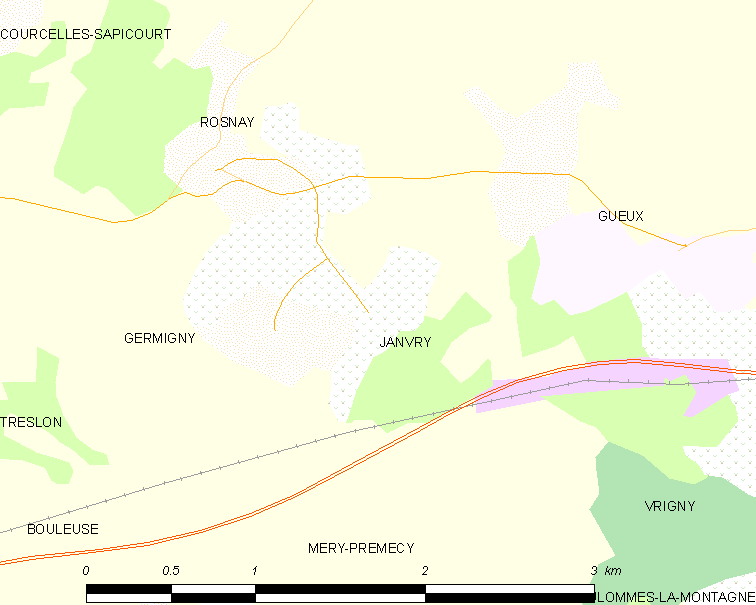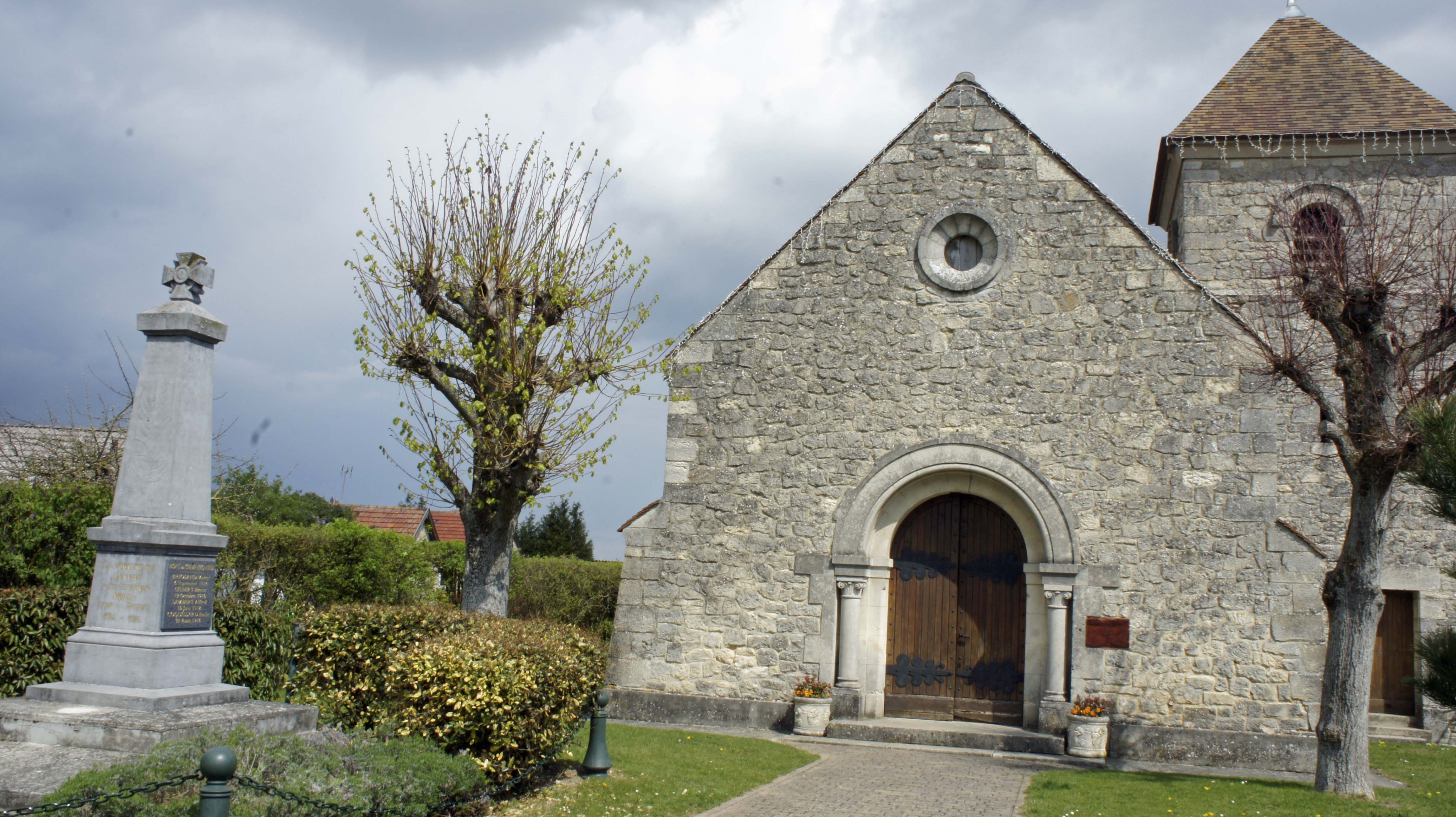 Key facts for Janvry
Key facts for Janvry
Located in: Montagne & Val de Reims: Vesle et Ardre
Vineyards and grape varieties: 35.0 hectares (86.5 acres), of which 79% Pinot Meunier, 12% Chardonnay and 9% Pinot Noir.
Classification: “Autre cru” (85%)
Map

The map is linked from Wikimedia Commons, and the geographical information originates from OpenStreetMap. The dotted white area corresponds to the vineyards, light yellow is other open terrain, and green indicates forest.
Neighbouring villages
East: Gueux
Southsouthwest: Méry-Prémecy
West: Germigny
Northwest: Rosnay

The church of Janvry, Église Saint-Remi. Picture linked from Wikimedia Commons (photo Garitan, 2012).
The village
Janvry is located on top of the Montagne de Reims hill, between the A4 motorway (between Paris and Reims) and the Ardre river. Janvry and Germigny Germigny and Janvry are located just a couple of hundred meters apart, but two villages are separate communes.
The area of Janvry, Germigny and Rosnay is sometimes called the Monts de Reims, not to be confused with the considerably larger area of Montagne de Reims.
The Janvry commune covers 194 hectares and has 137 inhabintants (as of 2012).
Vineyards
The vineyards in Janvry are located around the village and consist of mild slopes of varying direction, with Pinot Meunier as the most common grape variety.
The vineyards can be counted to the Vallée de la Vesle part of the Vesle et Ardre area, but locally the term Les Monts de Reims is also used for the vineyards in Janvry, Germigny and Rosnay.
The current vineyard surface in the Janvry commune is 35.0 hectares (86.5 acres). There are 27.6 ha Pinot Meunier (78.8%), 4.2 ha Chardonnay (11.9%) and 3.2 ha Pinot Noir (9.3%). Numbers from CIVC, as of 2013. In 1997, the vineyard surface was also 35 ha, but it was only in the 1950s when more extensive viticulture started in the commune. Today, there are 33 vineyard owners (exploitants) in the commune.
Single vineyard sites
- Les Hauts du Chapitre. Michel Beauchamp produces a cuvée (Pinot Noir and Chardonnay) from this site, under the name Cuvée Eliane Les Hauts Du Chapitre.
Champagne producers
Champagne growers
Producer status is indicated where known: RM = récoltant-manipulant, or grower-producers. RC = récoltant-coopérateur, growers that are cooperative members but sell Champagnes under their own name.
- Serge Armand
- Armand-Blin (RC)
- Beauchamp (RM), also Michel Beauchamp, a member of Vignerons Indépendantes with 6 ha of vineyards spread over the Massif de Saint-Thierry, Montagne de Reims, the Janvry area, the Aÿ area, Vallée de la Marne and Vallée de l’Ardre. The range includes a vineyard-designated Champagne, Cuvée Eliane Les Hauts du Chapitre (a blend of Pinot Noir andChardonnay) from a site in Janvry.
- Robert Gervais
- Lamblot (RC), has vineyards in the Montagne de Reims, Vallée de l’Ardre, and in the area around Janvry. Used to be called René Lamblot and has formerly been an RM.
- Jacky Martin (RC, also has a blog and a Facebook page), has 1.87 ha of vineyards in Janvry and Courcelles-Sapicourt, and an annual production of up to 12 000 bottles.
- Yves Masson (RC)
- Ponsart-Delagarde (RC)
- Saillard-Martin
- Clément Victor
Comment: It is not certain that the list is complete.
Cooperative
- Coopérative Vinicole de Germigny, Janvry, Rosnay, also called Coopérative Vinicole GJR, is a cooperative with 157 members with a total of 117.68 ha in some 40 villages. It was founded in 1961 by seven growers in Janvry who then had 17 ha between them. The cooperative sells its Champagnes under different brands with different profiles:
- CH. de l’Auche (CH. is supposed to be read out as C-H since they aren’t a château), where the Champagnes mostly consist of Pinot Meunier and sometimes a smaller proportion of Pinot Noir. This brand has been used since 1975 and the name was taken from a vineyard site that long have been used by the cooperative. The top cuvée is called La Cuvée du Chapitre, consist of 100% Pinot Meunier and is non-vintage.
- Prestige des Sacres (also has a Facebook page), where Pinot Meunier, Pinot Noir and also Chardonnay is used in the range, although not all three in all cuvées. The top wine of the range is traditionally a vintage Champagne called Cuvée Privilège that consists of Pinot Noir and Chardonnay (typically 50% of each), in similarity to a vintage rosé called Cuvée Grenat. In 2014, a new high-end Champagne was added: La Cuvée Boisée, consisting of 30% oaked Pinot Meunier and 70% Chardonnay. The name of the brand has been taken from the nickname of the city of Reims, la Cité des Sacres.
- Charles de Courcelle
- Hubert de Lossey, which as least earlier has been used as a brand, seems to have the same varietal composition as Ch. de l’Auche.
- Philippe de Morney
- Coopérative Vinicole GJR also provides Champagne Marquis de Sade with bottles. Marquis de Sade is a marque de acheteur (MA), i.e., a brand without production facilities of their own that is owned by the company Maison de Sade in the Parisian suburb Boulogne-Billancourt, and it is a descendant of the (in)famous marquis that is behind this company. The brand’s bottles have been supplied by different producers during the years. At the launch in 1989 (see this article in the NY Times) they were supplied by Michel Gonet in Avize.
Links
- Wikipedia about this village in English, in French.
- Website of the Janvry commune.
- UMC’s new village profile of Janvry.
- UMC’s old village profile of Janvry. (dead link)
- The Swedish version of this post.
© Tomas Eriksson 2015, last update 2015-09-13

